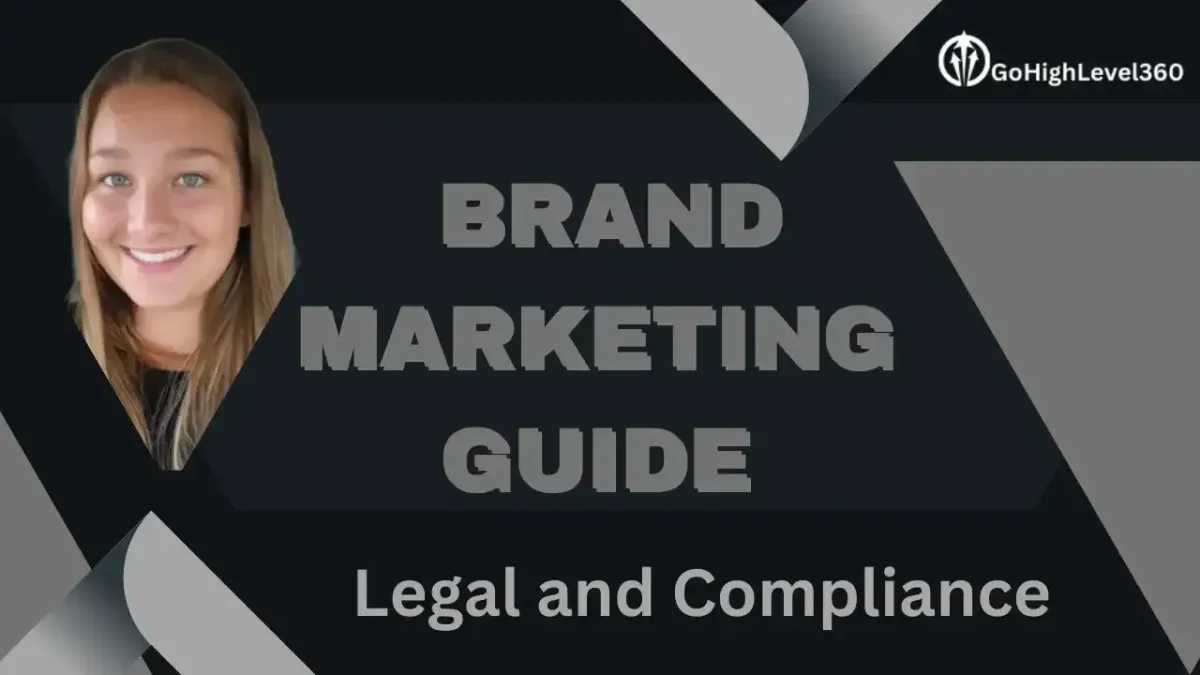"Leadership is not about titles, positions, or flowcharts. It is about one life influencing another." – John C. Maxwell
Go High Level 360
Legal Branding & Compliance

Legal Branding & Compliance
Table of Contents:
1. Introduction to Legal Branding and Compliance
Legal branding and compliance involve ensuring that all aspects of your brand and marketing activities adhere to relevant laws and regulations.
This includes protecting intellectual property, following advertising guidelines, and maintaining data privacy standards.
Building trust through transparency and integrity is crucial, which includes being legally compliant.
2. Importance of Legal Compliance in Branding
Ensuring legal compliance in branding helps to:
Protect Your Brand’s Intellectual Property: Safeguard your brand elements from unauthorized use.
Avoid Legal Disputes and Financial Penalties: Prevent costly legal battles and fines.
Build Trust and Credibility with Consumers: Show consumers that your brand operates with integrity.
Enhance Brand Reputation and Integrity: Strengthen your brand’s positive image.
Ensure Fair and Transparent Marketing Practices: Promote ethical advertising and marketing.
Safeguard Customer Data and Privacy: Protect customer information and comply with data privacy laws.
3. Key Legal Considerations for Branding
Trademark Protection: Register and protect your brand’s name, logo, and slogans.
Copyright Protection: Ensure original content and creative works are protected from unauthorized use.
Advertising Regulations: Comply with laws governing advertising practices, including truthfulness and transparency.
Data Privacy Laws: Adhere to regulations such as GDPR, CCPA, and other data protection laws.
Consumer Protection Laws: Ensure that marketing practices do not mislead or deceive consumers.
Contractual Agreements: Draft and manage contracts with partners, suppliers, and customers.
4. Steps to Ensure Legal Compliance in Branding
Conduct a Legal Audit: Review your current branding and marketing practices to identify potential legal risks.
Register Trademarks: Secure legal protection for your brand’s name, logo, and other identifying elements.
Protect Copyrights: Ensure all original content is properly copyrighted.
Comply with Advertising Laws: Follow regulations regarding truthful advertising, endorsements, and disclosures.
Implement Data Privacy Measures: Establish policies and procedures to protect customer data and comply with privacy laws.
Use Legal Disclaimers: Include necessary disclaimers in marketing materials to limit liability.
Seek Legal Advice: Consult with legal professionals to ensure compliance and address any legal issues.
5. Trademark and Copyright Protection
Trademarks: Register your brand’s name, logo, and slogans with the appropriate government authorities to prevent others from using them without permission.
Copyrights: Protect original content such as text, images, videos, and music by registering them with copyright offices.
Enforcement: Monitor the use of your trademarks and copyrights to identify and address any unauthorized use or infringement.
6. Advertising and Marketing Regulations
Truth in Advertising: Ensure all marketing claims are truthful, substantiated, and not misleading.
Endorsements and Testimonials: Disclose any material connections between endorsers and the brand.
Children’s Advertising: Comply with regulations governing marketing to children, such as COPPA.
Email Marketing: Follow laws such as CAN-SPAM and GDPR for email marketing, including obtaining consent and providing opt-out options.
7. Data Privacy and Security
Data Collection: Obtain consent from users before collecting personal data.
Data Protection: Implement security measures to protect customer data from breaches and unauthorized access.
Privacy Policies: Clearly communicate your data privacy practices to customers.
Compliance: Adhere to data privacy laws such as GDPR (EU), CCPA (California), and others relevant to your jurisdiction.
8. Case Studies of Branding Legal Issues
Apple vs. Samsung: Trademark disputes over product design and features.
Red Bull: Legal challenges related to misleading advertising claims.
Facebook: Data privacy violations and compliance issues under GDPR.
Nike: Trademark battles over the "Just Do It" slogan.
McDonald's vs. Supermac’s: Trademark conflict over the use of the "Big Mac" name.
Tiffany & Co. vs. Costco: Dispute over the use of the Tiffany trademark.
Adidas vs. Forever 21: Legal battle over the use of Adidas' signature stripes.
Louis Vuitton vs. Warner Bros.: Trademark infringement in the movie "The Hangover Part II.
"Google vs. American Blind & Wallpaper Factory: Dispute over trademarked search terms.
Starbucks vs. Charbucks: Trademark dilution case over a coffee company's name.
Burberry vs. Target: Trademark infringement for using Burberry’s check pattern.
Victoria's Secret vs. Victor's Little Secret: Trademark dilution and confusion case.
Nestlé vs. Cadbury: Legal battle over the trademark of the color purple.
Gucci vs. Guess: Trademark infringement case over the use of logos and patterns.
eBay vs. Internet "spiders": Legal action against companies scraping data from eBay.
9. Common Challenges in Legal Branding and Compliance
Complex Regulations: Navigating the complexities of different laws and regulations across jurisdictions.
Enforcement: Monitoring and enforcing intellectual property rights globally.
Data Protection: Keeping up with evolving data privacy laws and ensuring robust data security measures.
Transparency: Balancing marketing creativity with legal requirements for transparency and truthfulness.
10. Final Thoughts
Ensuring legal compliance in branding is not just about avoiding legal issues; it’s about building a solid foundation for trust, credibility, and long-term success.
By proactively protecting your intellectual property, adhering to advertising regulations, and safeguarding customer data, you not only protect your brand but also enhance its reputation and integrity.
As the regulatory landscape evolves, staying informed and adaptable is key. Engaging with legal professionals and continuously monitoring your compliance efforts will help you navigate challenges and maintain a strong, legally sound brand.
11. FAQs
What is the difference between a trademark and a copyright?
A trademark protects brand elements like names, logos, and slogans, while a copyright protects original works of authorship such as text, images, and music.
How do I register a trademark?
To register a trademark, file an application with the appropriate government authority, such as the USPTO in the United States, providing details about the mark and its use.
What are the key requirements for email marketing compliance?
Key requirements include obtaining consent, providing clear opt-out options, including sender information, and respecting privacy preferences.
Why is data privacy important in branding?
Data privacy is important because it protects customers’ personal information, builds trust, and ensures compliance with legal regulations, enhancing the overall brand reputation.
What should I do if my brand faces a legal challenge?
Seek legal advice immediately, review the situation thoroughly, and develop a strategy to address the issue transparently and effectively.
